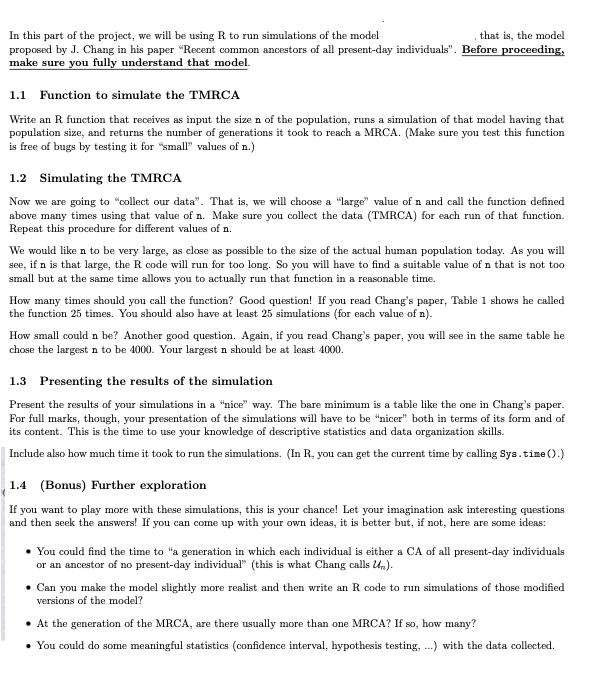Answered step by step
Verified Expert Solution
Question
1 Approved Answer
In this part of the project, we will be using R to run simulations of the model that is, the model proposed by J.

In this part of the project, we will be using R to run simulations of the model that is, the model proposed by J. Chang in his paper "Recent common ancestors of all present-day individuals". Before proceeding, make sure you fully understand that model. 1.1 Function to simulate the TMRCA Write an R. function that receives as input the size n of the population, runs a simulation of that model having that population size, and returns the number of generations it took to reach a MRCA. (Make sure you test this function is free of bugs by testing it for "small" values of n.) 1.2 Simulating the TMRCA Now we are going to "collect our data". That is, we will choose a "large" value of n and call the function defined above many times using that value of n. Make sure you collect the data (TMRCA) for each run of that function. Repeat this procedure for different values of n. We would like n to be very large, as close as possible to the size of the actual human population today. As you will see, if n is that large, the R code will run for too long. So you will have to find a suitable value of n that is not too small but at the same time allows you to actually run that function in a reasonable time. How many times should you call the function? Good question! If you read Chang's paper, Table 1 shows he called the function 25 times. You should also have at least 25 simulations (for each value of n). How small could n be? Another good question. Again, if you read Chang's paper, you will see in the same table he chose the largest n to be 4000. Your largest n should be at least 4000. 1.3 Presenting the results of the simulation Present the results of your simulations in a "nice" way. The bare minimum is a table like the one in Chang's paper. For full marks, though, your presentation of the simulations will have to be "nicer" both in terms of its form and of its content. This is the time to use your knowledge of descriptive statistics and data organization skills. Include also how much time it took to run the simulations. (In R. you can get the current time by calling Sys.time ().) 1.4 (Bonus) Further exploration If you want to play more with these simulations, this is your chance! Let your imagination ask interesting questions and then seek the answers! If you can come up with your own ideas, it is better but, if not, here are some ideas: You could find the time to "a generation in which each individual is either a CA of all present-day individuals or an ancestor of no present-day individual" (this is what Chang calls Un). Can you make the model slightly more realist and then write an R code to run simulations of those modified versions of the model? At the generation of the MRCA, are there usually more than one MRCA? If so, how many? You could do some meaningful statistics (confidence interval, hypothesis testing, ...) with the data collected.
Step by Step Solution
★★★★★
3.50 Rating (160 Votes )
There are 3 Steps involved in it
Step: 1
To fulfill the requirements of the project and conduct the simulations as described it is advisable to have a programming environment with R installed ...
Get Instant Access to Expert-Tailored Solutions
See step-by-step solutions with expert insights and AI powered tools for academic success
Step: 2

Step: 3

Ace Your Homework with AI
Get the answers you need in no time with our AI-driven, step-by-step assistance
Get Started


